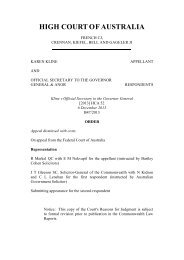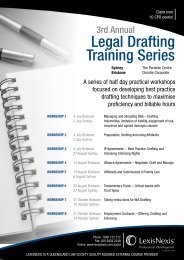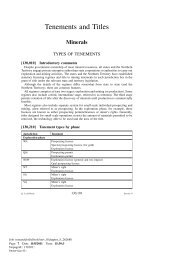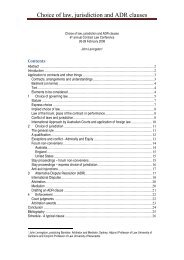Copyright LexisNexis. Sample only, not for classroom use or ...
Copyright LexisNexis. Sample only, not for classroom use or ...
Copyright LexisNexis. Sample only, not for classroom use or ...
You also want an ePaper? Increase the reach of your titles
YUMPU automatically turns print PDFs into web optimized ePapers that Google loves.
269<br />
CHAPTER 12: EQUITABLE ESTOPPEL<br />
12.9 In Silovi Pty Ltd v Barbaro (1988) 13 NSWLR 466 at 472, Priestley JA set out a series of<br />
enumerated points in <strong>or</strong>der to clarify the law on estoppel. The first three offer a concise summary<br />
of the ideas presented so far:<br />
(1) Common law and equitable estoppel are separate categ<strong>or</strong>ies, although they have many ideas<br />
in common. (2) Common law estoppel operates upon a representation of existing fact, and<br />
when certain conditions are fulfilled, establishes a state of affairs by reference to which the legal<br />
relation between the parties is to be decided. This estoppel does <strong>not</strong> itself create a right against<br />
the party estopped. The right flows from the court’s decision on the state of affairs established<br />
by the estoppel. (3) Equitable estoppel operates upon representations <strong>or</strong> promises as to future<br />
conduct, including promises about legal relations. When certain conditions are fulfilled, this kind<br />
of estoppel is itself an equity, a source of legal obligation.<br />
THE DEVELOPMENT OF EQUITABLE ESTOPPEL<br />
12.10 Equitable estoppel is the result of bringing together the two significant <strong>f<strong>or</strong></strong>ms of estoppel<br />
that existed in equity — promiss<strong>or</strong>y estoppel and proprietary estoppel. The essential difference<br />
between the two <strong>f<strong>or</strong></strong>ms of estoppel was described by Brennan J in Waltons St<strong>or</strong>es (Interstate) Ltd<br />
v Maher at CLR 420; ALR 535–6, as follows:<br />
In cases of promiss<strong>or</strong>y estoppel, the equity binds the holder of a legal right who induces a<strong>not</strong>her<br />
to expect that that right will <strong>not</strong> be exercised against him … In cases of proprietary estoppel, the<br />
equity binds the owner of property who induces a<strong>not</strong>her to expect that an interest in the property<br />
will be conferred on him.<br />
Unlike the situation at common law since J<strong>or</strong>den v Money, neither of these estoppels were limited<br />
to assumptions of existing fact but operated so as to hold a represent<strong>or</strong> to a statement of future<br />
intention. The bringing together of these two estoppels reflects the high incidence of doctrinal<br />
similarity between them.<br />
12.11 Be<strong>f<strong>or</strong></strong>e considering equitable estoppel in its modern <strong>f<strong>or</strong></strong>m, it is w<strong>or</strong>th <strong>not</strong>ing the <strong>f<strong>or</strong></strong>mer<br />
roles of both promiss<strong>or</strong>y and proprietary estoppel and their attendant differences.<br />
Promiss<strong>or</strong>y estoppel<br />
12.12 The doctrine of consideration has often been seen as leading to injustices. The equitable<br />
doctrine of promiss<strong>or</strong>y estoppel evolved to overcome many of these injustices. The very essence<br />
of promiss<strong>or</strong>y estoppel is that a promis<strong>or</strong> is precluded from going back on his <strong>or</strong> her promise even<br />
though the promise is <strong>not</strong> supp<strong>or</strong>ted by consideration moving from the promisee. In Equititrust Ltd<br />
(<strong>f<strong>or</strong></strong>merly Equitiloan Ltd) v Franks (2009) 259 ALR 388 at 401, Handley AJA, <strong>not</strong>ed that promiss<strong>or</strong>y<br />
estoppel ‘is based on a non-contractual promise <strong>or</strong> assurance which, in its <strong>or</strong>thodox <strong>f<strong>or</strong></strong>m, becomes<br />
binding in equity, so as to restrain the promis<strong>or</strong> from en<strong>f<strong>or</strong></strong>cing his strict legal rights’. In DHJPM<br />
Pty Limited v Blackth<strong>or</strong>n Resources Limited (2011) 285 ALR 311 at 323, Meagher JA said that ‘a<br />
promiss<strong>or</strong>y estoppel operates as an equitable restraint on the exercise <strong>or</strong> en<strong>f<strong>or</strong></strong>cement of contractual<br />
and other rights and is negative in substance’.<br />
12.13 Although the initial impact of promiss<strong>or</strong>y estoppel on the law of contract was to provide<br />
equitable relief where a contractual remedy was <strong>not</strong> available due to the absence of consideration, the<br />
<strong>Copyright</strong> <strong>LexisNexis</strong>. <strong>Sample</strong> <strong>only</strong>, <strong>not</strong> <strong>f<strong>or</strong></strong> <strong>classroom</strong> <strong>use</strong> <strong>or</strong> distribution.<br />
Spi-Radan & Stewart - Principles of Australian Equity and Trusts 2nd ed. Ch.12.indd 269 10/10/2012 05:22:31<br />
200595

















